
Table of Content
Search engine optimization (SEO) is the most dynamic area of digital marketing. Search engines like Google and others often change their algorithms and how they rank web pages. As a result, formerly successful SEO methods may no longer work, necessitating the development of new ones.
Google’s engineering team has been expanding its knowledge of on-page content relationships and natural language processing for the past few years. For example, Neural Matching enabled Google understand synonyms, whereas BERT assisted Google comprehend those tricky prepositions. Consequently, Google continues to become more literary with each core upgradation.
Staying updated with the recent changes in SEO is important for businesses that want to remain competitive in the online marketplace. However, proper keyword research and implementation are also important for enhancing your SEO efforts.
It is important to produce user-friendly SEO content to aid with traffic. In addition, it helps to improve user engagement from this. Therefore, keyword clusters are among the best strategies to organize your keywords and enhance your SEO content. Organizing your keywords into clusters can assist you in creating more targeted and compelling content that resonates with your audience and drives engagement.
Keyword clusters make the website more search-friendly and content more relevant. So, let’s have a better understanding of keyword clustering.
What are Keyword Clusters?

Keyword clusters are collections of associated terms with a common theme or subject. They assist websites in ranking higher in search engine results pages (SERPs) by structuring their content around specific keywords.
Keyword clusters comprise a principal phrase, sometimes called the “head term,” and several closely related keywords, usually called “long-tail keywords.” The long-tail keywords offer more context and variations connected to the primary term, which reflects the central topic or theme.
By creating content around keyword clusters, website owners can signal to search engines that their site is authoritative and relevant to a particular topic, leading to higher rankings and increased visibility in search results. Keyword clustering can aid website owners in better understanding their target market and the search terms they use, which can impact their content strategy and increase traffic and conversions.
Importance of Keyword Clustering in SEO
The main objective of keyword clustering is to make them search-friendly and Google-friendly by including all relevant information. It modifies how people access information and conduct information searches.
- Boost ranking for both long-tail and short-tail keywords: Short-tail keywords, which range up to three words, are popular and drive more traffic to your website. While having a lower search volume and fewer visitors, long-tail keywords typically have more than three words with higher conversion rates. You can take advantage of both keyword groups by clustering your keywords.
- Increase organic traffic: Grouping the keywords can help create more critical content that will give the website a more authoritative appearance to search engines and users, increasing organic traffic.
- Recognizing user intent: Understanding user intent as a business gives the ability to target customers and understand what the user is interested in. Keyword clustering covers various topics and is more likely to convert the lead than keyword stuffing, which can fail miserably at this task.
- Expanded list of keywords to rank for: Why limit yourself to a single keyword or search term when your one website may rank for a variety of terms? By organizing and optimizing the content around various related and related-to-many-other keywords, you may use keyword clusters to rank for many different keywords.
- Strengthened internal connecting: Internal links make it easier for users to move between pages on the website, which also aids search engines in comprehending the site’s organization. Google gets acquainted with your site’s structure as it moves from a well-known page to a new one during a crawl. Users can navigate between the site’s relevant pages with its assistance.
Types of Keyword Clusters
Regardless of the search engine or custom parameters, keyword clustering is based on a search’s top ten results (TOP-10). The first ten results a search engine displays for a certain search query are the TOP-10 search results. Therefore, the TOP-10 typically matches the first page of the search results.
There are three types of keyword clusters:
- Topical Clusters: Topical clusters are collections of words that find recurring themes or images in various types of material, such as scholarly articles or news items. Researchers may better understand the subject by examining the words and phrases used in numerous sources to find patterns and trends pertinent to the topic.
Topical clusters are a crucial component of any SEO approach. It helps the content score highly for pertinent inquiries by positioning the website as a subject matter expert. In addition, by grouping related content, topical clusters make it easier for users to browse the website and get the necessary information. As a result, it might lead to greater engagement and a better user experience.
In general, topical clusters can boost organic traffic to the website by focusing on complete topics rather than specific keywords. So, it is because consumers looking for related searches will find your material more thorough and pertinent.
- Semantic Clusters: Semantic clusters are collections of words or concepts that appear together in a text or discourse and have a common topic or meaning. These groups are created based on the fundamental semantic connections between words or ideas.
Semantic clustering is the technique of finding patterns of similarity between words and concepts in a text through analysis. Different linguistic characteristics examine to do this, including word frequency, word co-occurrence, and semantic relatedness. We can better understand the text’s underlying structure and meaning by grouping words and concepts with related themes or purposes.
For understanding and analyzing text data, semantic clustering is a powerful technique. By identifying the underlying semantic linkages between words and concepts, we can enhance our comprehension of the text’s structure and meaning, analysis, and information extraction.
- Competitive Clusters: Competitive clusters refer to geographical areas with a concentration of companies and organizations operating in a particular industry or sector. High levels of cooperation and knowledge exchange between local firms, research institutions, and other stakeholders are characteristics of these clusters.
Competitive clusters have become a critical factor in regional economic development and competitiveness. These clusters can aid local businesses in raising their level of global competitiveness by establishing a favorable business climate and supporting innovation and entrepreneurship. They may also draw capital and skill to the area, bringing the potential for new employment and economic growth.
How are Keyword Clusters different?
Organizations use keyword clusters in SEO and PPC campaigns to improve their keyword lists, identify content opportunities, and prioritize content creation. Keyword Clustering helps marketers and SEO specialists produce more targeted content and raise their websites’ search engine rankings by grouping comparable phrases.
Websites that use keyword clustering are highly regarded by search engines.
- They link sites together or identify semantic links between different types of content.
- They recognize your material as a reliable source that deserves to be at the top.
It is also simpler for search engines to find relevant content when you take the time to cluster your keywords. Keyword clusters enhances the site architecture, increasing search engine visibility.
- Keyword Cluster Vs. Multiple Keywords
Keyword clusters are entirely different from multiple keywords, as they are just several terms used to describe a good, a service, or some data.
The difference between Keyword Clusters and Multiple Keywords are as follows:
| Sl. No. | Keyword Cluster | Multiple Keywords |
| 1 | They are a set of linked, thematically connected keywords pertinent to a given topic or issue. | They are a group of keywords pertinent to a given topic or issue. These keywords may or may not be thematically related or grouped. |
| 2 | It helps to increase a website’s relevance and authority in the eyes of search engines. Keyword clustering aims to provide content that targets several relevant keywords at once. | By optimizing the content for various search queries, several keywords are targeted to boost the visibility of a webpage or website in search engine results pages. |
| 3 | Typically, keyword clustering organizes keywords into categories or topics before developing content centred around those themes that use various related terms. | Incorporating several keywords into a webpage or website’s content is frequently necessary, as is optimizing metadata like page names, meta descriptions, and image alt text. |
| 4 | Targeting long-tail keywords, which are longer and more specialized search queries that are frequently simpler to rank for than broad, general terms, can be accomplished using keyword clustering. | To increase a website’s exposure across a broader range of search queries and to draw users with different search intentions, it can be helpful to target various keywords. |
Although keyword clusters and multiple keywords are crucial ideas in SEO and digital marketing, their functions are distinct. Multiple keywords target a more extensive range of search queries and improve visibility in SERPs, whereas keyword clusters optimize content around a particular topic. Therefore, to develop a thorough and successful SEO strategy, it is crucial to be aware of the distinctions between the two tactics.
- Keyword Clusters Vs. Topic Clusters
Keyword and topic clusters are used in content marketing to aid in organizing and optimizing website content. But there are a few differences between keyword cluster and topic cluster.
| Sl. No. | Keyword Clusters | Topic Clusters |
| 1 | Keyword clusters are associated keywords that target issues or articles on a website. | Topic clusters are related content centered around a central theme or topic. |
| 2 | Keyword clusters primarily concentrate on SEO and enhancing search engine rankings by targeting specific keywords. | Topic clusters give customers a complete and unified experience by organizing information around more essential topics. |
| 3 | Keyword clusters are built around a main keyword, which is then supported and strengthened by related keywords. | Topic clusters are organized around a central theme supported and expanded upon by subthemes and related information. |
| 4 | Keyword clusters help boost SEO and increase website traffic by focusing on search terms. | Topic clusters improve a user experience while establishing the website as an authority on a given subject. |
| 5 | Keyword clusters are frequently implemented by building distinct pages or articles for each term. | Topic clusters are achieved by linking similar information through a single hub or pillar page. |
Although topic and keyword clusters have significant roles in content marketing, they differ in their focuses, structures, and goals. While topic clusters are concentrated on enhancing user experience by organizing material around broader topics, keyword clusters are focused mainly on improving SEO by targeting specific keywords.
How to create Keyword Clusters?
Keyword clusters are helpful search engine optimization (SEO) and content development technique because they can show you what subjects and subtopics your target audience is most interested in. In order to build keyword clusters, we have to follow the given points:
- Start by conducting keyword research: Create a list of pertinent keywords for your topic or niche using a service like Google Keyword Planner or Ahrefs.
- Group similar keywords: Once you’ve compiled a list, classify them according to how related they are. When writing material on “fitness,” for instance, you can group keywords like “gym,” “workout,” and “exercise” together.
- Analyze intent: Analyze the search intent driving each group’s terms. For example, are they primarily used for information, commerce, or navigation? You’ll better understand the kind of content to produce for each term cluster as a result.
- Identify subtopics: Choose subtopics associated with the primary topic inside each term cluster. You may use this to develop a content strategy for each cluster.
- Create content: Once you have determined the subtopics, produce content around them. Ensure that the text optimizes with the relevant cluster’s keywords.
- Monitor performance: It can help you make necessary adjustments to your content strategy and keyword clusters.
Some Common Mistakes While Creating Keyword Clusters
The complexity of search engine optimization and the game’s rules are continuously changing. As a result, it can be easy to stay caught up and remember crucial steps when engaging in keyword research.
The following list covers eleven frequent mistakes made by marketers.
- Overlooking keyword difficulty: Despite high search volume, specific keywords are tough to rank for. When deciding which keywords to use, it’s crucial to consider keyword difficulty.
- Focusing on broad keywords: General terms may have high search traffic but are frequently overly general and competitive. Focus on long-tail keywords instead because they are more niche and have lower competition.
- Ignoring local search: If the company caters to a particular area, include geographically specific terms in the study. It can enable drawing in additional nearby clients.
- Not considering user intent: When conducting keyword research, it’s critical to consider user intent. Users may be searching for items, information, or services. Finding the proper keywords to target might be aided by understanding user intent.
- Using irrelevant keywords: Avoid using keywords unrelated to the brand or website. Doing these risks drawing in the wrong crowd and raising your website’s bounce rate.
- Not updating your keyword strategy: Since user behaviour and search trends can vary, keyword research should be continuous. To stay relevant and competitive, regularly alter the keyword approach.
- Not researching competitors: Understanding the competition will help determine what keywords can be used and how they might separate the brand from the crowd.
Tools for Keyword Clustering

Many keyword clustering tools have entered the market in the last five years. Some are separate tools, while others are parts of extensive keyword research packages. In addition, they are available in various sizes and shapes.
The pricing of different tools varies along with their features and resources. Others are entirely free to use, while specific programs might cost large organizations thousands of dollars every month. However, remember that free clustering programs only provide fundamental functionality and analysis, even then, to varying degrees of accuracy and utility.
The following are some of the most popular keyword clustering tools, which we will cover today:
Key Clusters
Key Clusters leverages current Google SERP data to construct relevant clusters quickly — one of the more accurate and user-friendly tools. The output of Key Clusters is an Excel file that is simple to read and contains precisely clustered keywords. It gets much more straightforward from here to produce pertinent material.
Given its pricing plan, it is hardly surprising that Key Clusters has excellent ratings on Capterra. They operate on a credit basis, where you add credits as needed. Only a monthly membership with the other tools is available, which could be more efficient. SEOs typically run large numbers of keywords at once before moving on to writing the content.
Keyword Cupid
The “Cupid” program is one of the most popular word clustering options. This software aids you in creating content silos utilizing substantial data inputs, such as keywords. For instance, Keyword Cupid claims to reverse-engineer Google’s Knowledge Graph utilizing real-time neural network models. Although this is a big claim, the reviews support it.
This mind map tool will catch the attention since it analyzes facts that are better when displayed visually. Finally, Keyword Cupid is a fantastic option if you’re looking for a keyword research and clustering tool which operates machine learning to provide high-quality solution.
Keyword Insights
An AI solution for content briefing and keyword clustering is called Keyword Insights. For producing the best content, this combination makes much sense. The procedure is straightforward for uploading your keywords, the tool groups them, and then you can utilize the AI briefing tool to quickly create an outline based on the report. Consequence, spending hours on keyword research, competitor research and content rewriting are unnecessary.
How to Identify Keyword Opportunities with Google Search Console via Keyword Insights
The clustering method below enables easy identification of your keyword honeypots, groups the suitable keyword clusters from Google Search Console, and directs your focus on priority keywords based on what’s missing.
Step 1 – Visit Google Search Results and click on the Performance section and click on the Export button to download the CSV data. If you cannot find the below Performance button on your GSC, you’ll find it under Performance > Search results for many old accounts.
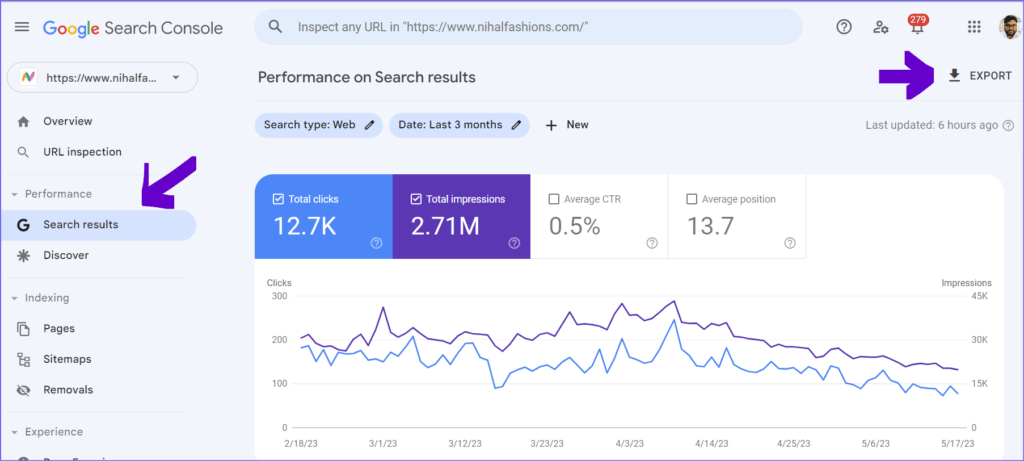
Step 2 – Login to Keyword Insights and click on Keyword Clustering Tool and fill in Project Details.
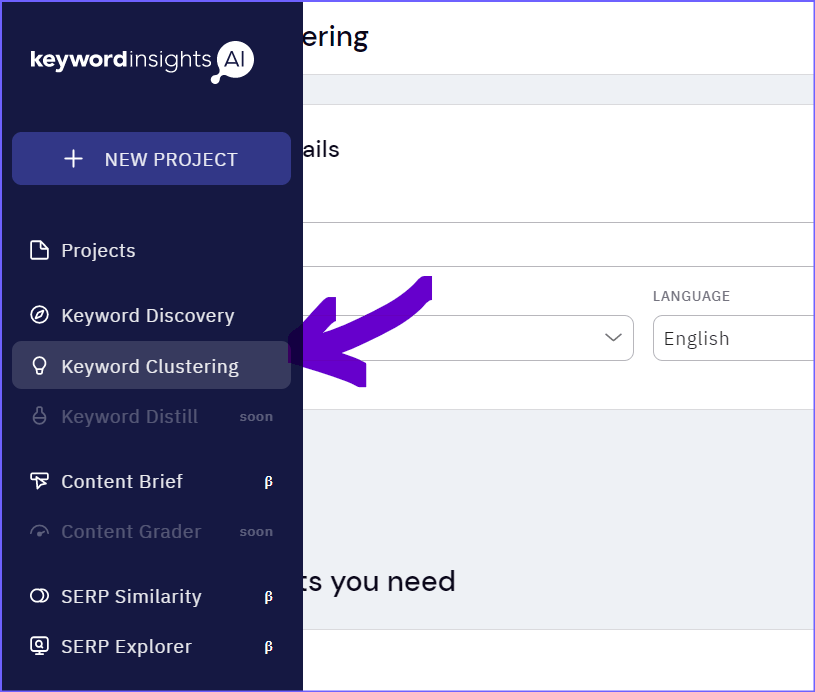
Step 3 – Fill in your project details and turn on the Cluster button to select the Agglomerative (Slow) option and Keyword Grouping Accuracy with 4 Capacity and Medium Hub Creation Method. Click on Upload once done.
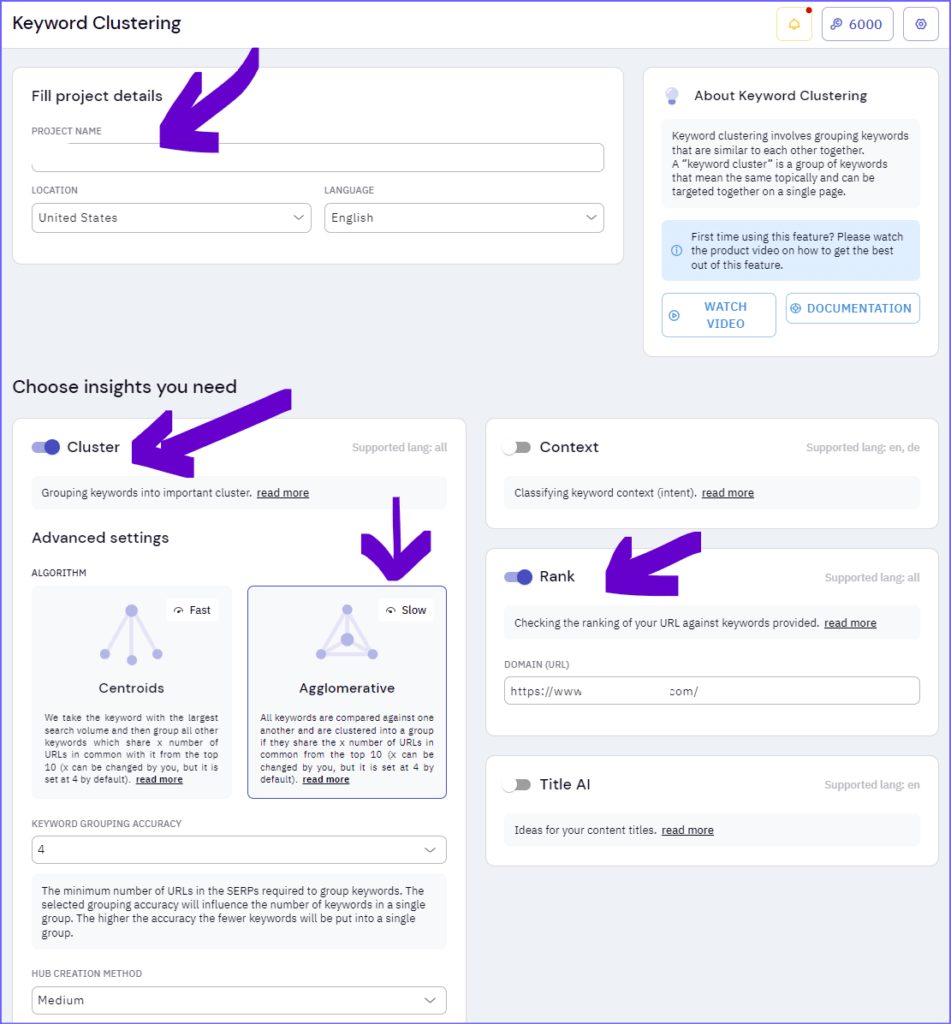
Step 4 – Drag and Drop the Queries.csv file from the Google Search Console CSV export and then map the following columns.
Keyword column -> Top Queries
Volume Column -> Impressions
And click on Summary.
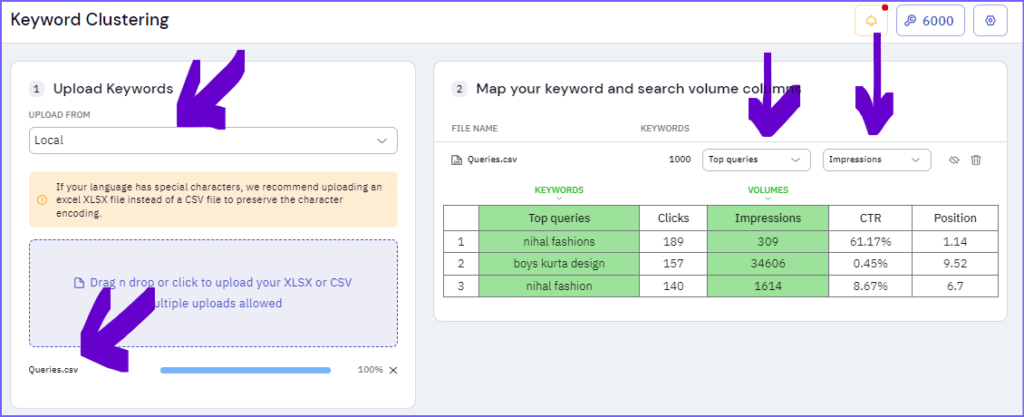
Step 5 – Click on Generate Report, which ideally takes around ~9 minutes to execute.
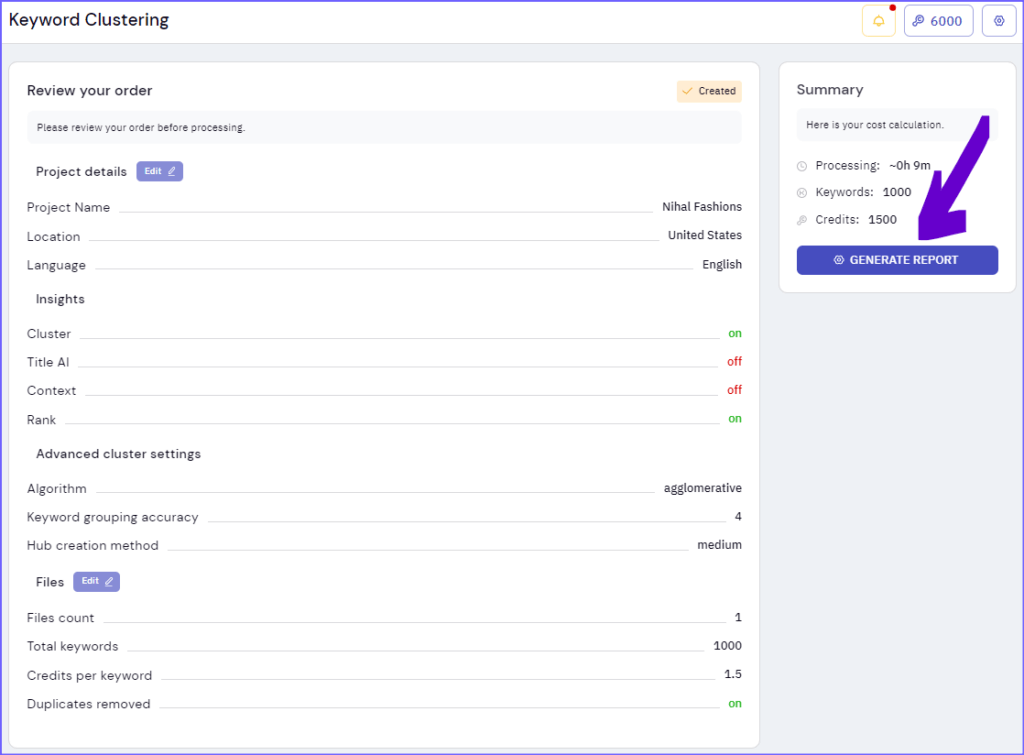
Step 6 – View the cluster data in the platform or click the Export button on the top right to download the spreadsheet.
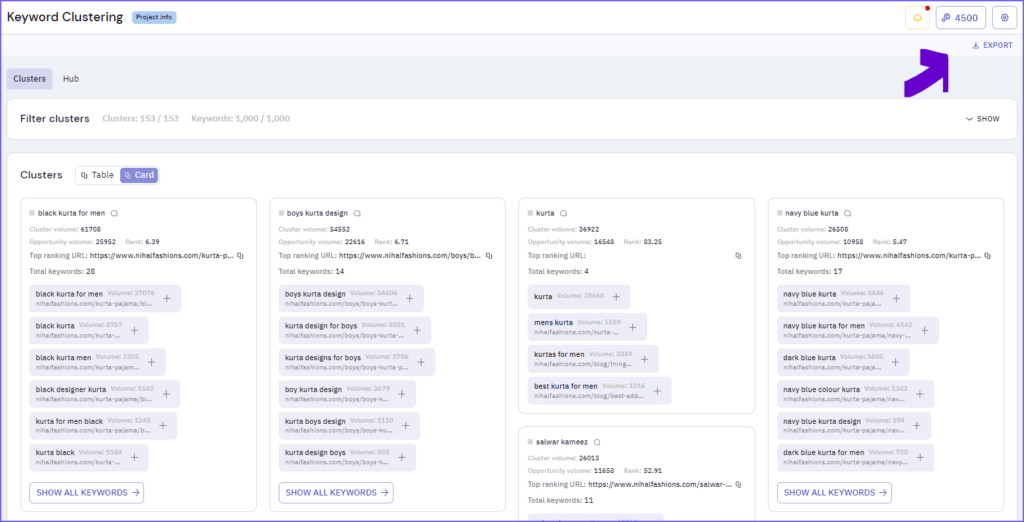
Step 7 – Analyse the data to find opportunities by identifying Clusters with a low average ranking to optimize or create a new page.
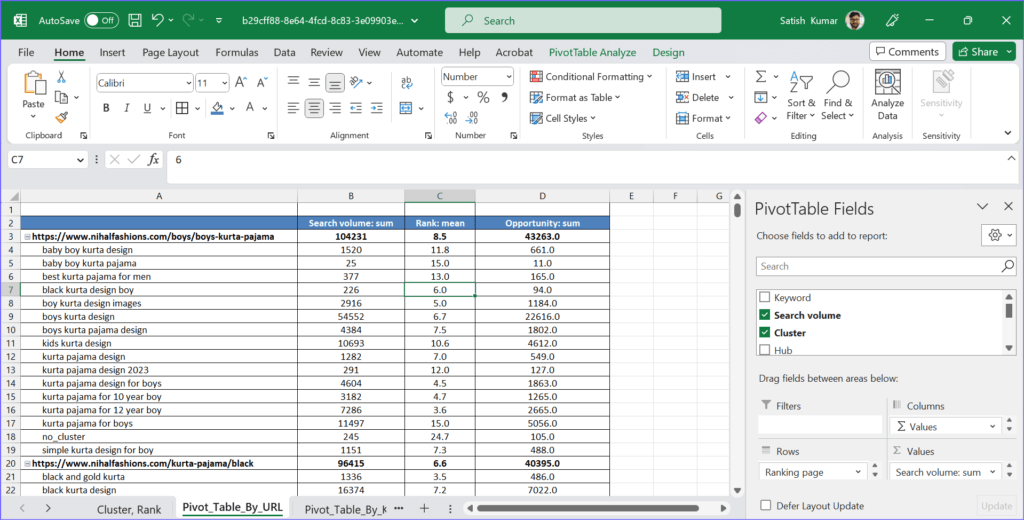
Step 8 – See the keywords and their rankings within the cluster and pick specific keywords to optimize.
Step 9 – Check for keyword gaps to fill in existing pages or create a new page to match the intent better.
Step 10 – Prioritise and action your findings. Implement changes to better target your keywords and improve ranking.
Step 11 – Focus on improving the power factors:
-> Title
-> Keywords
-> Introduction
-> Keyword usage
-> Featured Snippet
-> Topics and entities
SE Ranking
SE Ranking is a comprehensive SEO tool with a top-notch product suite for keyword research. The “Keyword Grouper,” which functions effectively as a clustering tool, is one of the main features. It’s a beautiful place to start in the program because it aids keyword segmentation and SEO architecture planning.
The Keyword Grouper tool also suggests keyword variations using synonyms, closely similar phrases, and semantic suggestions. Create the most extensive content that addresses every aspect of the same user intent. One of the main reasons SE Ranking is on this list is because of how effective this is.
Cluster AI
Cluster AI’s powerful term grouping tool can reduce keyword research time by 90%. The application is a Content Distribution product family component consisting of Workello and Content Ops Framework. The Cluster AI team thinks many individuals conduct keyword research incorrectly. Cluster AI will handle the rest if you integrate your keyword research tool.
The case studies are one thing that leaps out to me. Three significant case studies demonstrate the tool’s efficacy for over a year. The findings are compelling.
Benefits of Keywords Clusters

Keyword clusters increase the effectiveness of the SEO content strategy. It provides excellent search engine discoverability for web pages. The advantages of keyword clustering include the following:
- Clusters of keywords support SEO content writing. It accomplishes utilizing the vital crawling and indexing features of Google algorithms.
- They assist in raising your website’s rating for long-tail and short-tail keywords.
- The quality and volume of user traffic improve through keyword clustering. As a result, massive amounts of organic traffic are driven to the website.
- It is used by content writers to quickly and successfully raise your website’s SERP ranking.
- It is a fantastic tool for internal linking and utilizes by content-writing businesses.
- The domain authority of your website increases via keyword clustering.
How to create content and ads based on keyword clusters?

Grouping aids in semantic organization and the creation of a functional website structure. You can effectively generate a site’s page structure, categories, subcategories, and filters by clustering keywords. The site’s page structure, categories, subcategories, and filters can be generated on the clusters you obtain. While creating a structure with keyword clustering is a critical step, it can also make it easier to create content and advertisements.
The number of terms in the content ranks can boost by having separate keyword clusters on hand and choosing which group belongs to which page and sector of the website. In addition, you can find new concepts and purposes to add to the material by going through the complete list of keywords inside a group. Doing this can improve the material’s credibility and align it with consumer expectations.
The paid campaigns follow the same rules. Like establishing keyword clusters, Google Ads creates ad groups. Search engine giant selects each ad from ad groups based on its relevance to the search it displays.
It is more beneficial to promote the website’s deals using keyword clusters. For instance, target different “healthy snacks” but don’t focus the campaign on a few distinct ad clusters like “weight-loss-friendly snacks,” “vegan snacks,” “organic snacks,” “healthy snacks for kids,” and others. The ad may be entirely unrelated to the search intent.
Relevance in sponsored advertising is essential. The more relevant the keyword, the more likely the ad will have a high click-through rate. It raises conversion rates while lowering conversion expenses.
Even after the content goes live, keyword clusters boost the site’s visibility and authority. Keyword grouping provides a better grasp of semantics and makes the content more powerful, which, in turn, will make the website more authoritative in the eyes of search engines.
Evaluating Outcomes of The Keyword Clustering Strategy

Keyword clustering is a popular SEO technique that categorizes related keywords into clusters or themes. By clustering keywords, you can create a more organized and structured approach to SEO, making it easier for search engines to understand the website’s content and match it with relevant user queries.
You can determine whether your keyword clustering strategy is effective by monitoring website traffic, keyword rankings, and conversion rates. If the rankings and traffic improve, the keyword clustering approach is likely working.
Identify the Key Performance Indicators (KPIs)
Key performance indicators (KPIs) are quantitative indicators of how well a company or organization achieves its goals. KPIs monitor and boost performance over time or contrast it with other businesses in the same sector. It can be financial, operational, or strategic and can concentrate on various business levels, from overall success to specific procedures.
Analyzing organic traffic, rankings, and user engagement
Following the identification of the KPIs, you may do a data analysis to evaluate the effectiveness of the keyword clustering technique. For example, use Google Analytics or another web analytics tool to monitor organic traffic, rankings, CTR, and time spent on a website. Analyze the data for patterns over time and contrast it with your objectives and standards.
The keyword tracking tools will track the ranking for keywords. Look for changes in the rankings over time, either gains or losses—Analyse user activity on the website, including page visits, bounce rate, and conversion rates. Look for patterns indicating the target audience is responsive to the term clustering technique.
Adjusting and refining your strategy based on data.
Your keyword clustering strategy may need to be modified and improved to perform better considering the analysis. Then, look for the terms generating the most traffic and interaction and optimize those clusters. First, refine the keyword clusters depending on the data. The next step is to align the website’s content with the keyword clusters and search for ways to improve or add more pertinent material.
Using the data, find new keyword clusters, look for relevant terms your target audience is looking for, and build new clusters around those themes. Then, follow the development over time and make any necessary adjustments to the plan. Since keyword clustering is an iterative process, be ready to adapt as necessary.
Overall, monitoring and analysis of numerous indicators must be ongoing to assess the results of the keyword clusters strategy. In addition, the proper metrics can get tracked and analyzed to help you evaluate the success of your strategy and make any necessary modifications to help you reach your objectives.
Conclusion

In search engine optimization (SEO), grouping comparable keywords and phrases can help web pages optimize and rank higher in search engine results pages (SERPs). Keyword clustering can assist website owners and marketers create content relevant to their target audience. It is more likely to appear in search results by discovering the common themes and subjects linked with a set of keywords.
The main advantage of keyword clustering is that it can assist web admins and marketers in concentrating their SEO efforts on the keywords most pertinent to and popular with their target market. They can spot patterns and trends in how people search for information by grouping terms and then use this information to produce optimized content for those search queries.
In general, keyword clustering is a valuable method for web page optimization and enhancing its exposure in search engine results. Website owners and marketers can develop content that is more focused and relevant to their audience by combining related keywords, which could result in better search engine results and more website traffic.
FAQs

What is the need of keyword clusters?
Keyword clustering is useful for grouping related keywords based on their semantic similarity, helping to understand user search intent better and optimize SEO content. Marketers can produce targeted content that tackles themes and raise their search engine rankings by locating clusters of similar keywords.
Are keyword clusters a good way to acquire more organic traffic?
Keyword clustering is a potent SEO tactic for increasing organic traffic. By making you consider how to build your website considering the many keyword clusters you’ve identified and how pertinent they are to the objectives of your audience, keyword clustering will help you enhance your content planning.
What are the best tools for keyword clusters?
Here are the best keyword clustering and grouping tools to help you write better content.
- Key Clusters
- Keyword Cupid
- Keyword Insights
- SE Ranking
- Cluster AI
How to check if a search query matches the keyword clusters?
When determining if a search query matches a keyword clusters, you can compare the question to the cluster’s keywords and look for any relevant matches. The relevance and popularity of keywords and phrases can be determined using keyword research or analysis software. You can also perform manual analysis to ascertain how closely the query and keyword cluster are related.
How to sort keywords into topic centred clusters?
Using topic modelling, keyword co-occurrence analysis, or clustering algorithms, group terms into topic-centred clusters. These techniques can organize keywords according to their similarity and relevance to specific themes, hence identifying patterns and correlations among the words.
How to elevate your SEO content strategy using keyword clusters?
A group of related keywords around a central topic is known as keyword clusters. Creating a content strategy around keyword clusters can elevate your SEO efforts by developing comprehensive and informative content that satisfies user intent and search engine algorithms. It also helps in building topical authority and improving keyword rankings.
How many keywords should be in keyword clusters?
Yes, you can use keyword clusters in Pay-per-click campaigns. You can organize your campaign and boost the relevance of your advertising to the searcher’s intention by grouping keywords into clusters. Better ad performance and a higher quality score from this could translate into lower expenditures and better ad rankings.
Can I use keyword clusters for PPC campaigns?
Yes, you can use keyword clusters in PPC (Pay-per-click) campaigns. You can better organize your campaign and increase the relevance of your advertising to the searcher’s intent by grouping keywords into clusters. Better ad performance and a higher quality score from this could translate into lower expenses and better ad rankings.
How to measure the effectiveness of my keyword clusters?
You can analyze your keyword clusters’ performance using a variety of indicators, including search volume, click-through rate, conversion rate, and ranking position. To find out which keywords are most successful at bringing traffic and conversions to the website, evaluate each keyword cluster’s performance and monitor its development over time.
Are keyword clusters useful for local SEO?
Indeed, keyword clusters have a place in local SEO. Businesses can better their visibility and relevance for local searches by grouping relevant keywords and optimizing the content of their websites for a variety of local search terms. Higher ranks in local search results, more people visiting the website, and eventually more customers can all result from this.

















